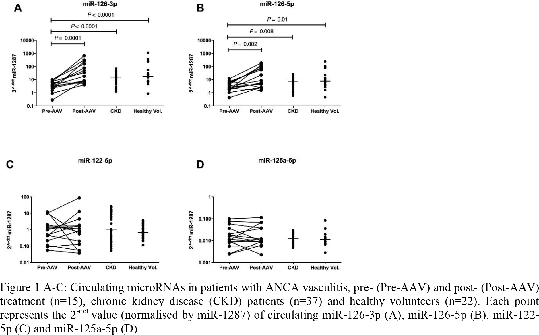Print version
Search Pub Med
| 080P London, UK Pharmacology 2017 |
Circulating microRNA-126 reports vascular dysfunction and response to treatment in ANCA vasculitis
Introduction: There is an unmet clinical need for biomarkers to report vascular health and injury. Vascular and kidney dysfunction commonly co-exist and contribute to cardiovascular risk (1). MicroRNAs are essential for regulation of many protein-coding genes and can exhibit a strong level of organ specificity, which make them a significant emerging class of biomarker. MicroRNA-126 is endothelial cell-enriched and present throughout the vasculature (2). This study hypothesised that microRNA-126 would be a biomarker of vascular integrity and would change with vascular injury and track treatment-induced improvement in vascular function.
Method: Samples were analysed from patients with chronic kidney disease (CKD) and small vessel vasculitis associated with autoantibodies to neutrophil cytoplasmic antigens (ANCA), a model of acute vascular and renal injury. Serum samples were analysed by small RNAseq from healthy volunteers and patients with vasculitis at first presentation to the treating clinician (pre-treatment) and in treatment-induced remission (post-treatment) using the BGISEQ-500 platform. Blood was collected from patients with ANCA vasculitis pre- and post-treatment (n=15), healthy subjects (n=22) and patients with CKD (n=37). From the patient samples, miR-126-3p and -5p, miR-122-5p (control - liver-specific), miR-125a-5p (control - associated with systemic lupus erythematosus), and miR-1287 (internal normaliser) expression levels were measured by qPCR.
Results: We found that CKD and vasculitis patients presented with lower levels of microRNA-126-3p and -5p than healthy volunteers (Figure 1A and 1B). Upon successful treatment of vasculitis, post-AAV, microRNA-126 expression levels increased to near healthy levels. In contrast, there was no difference in liver-specific microRNA-122-5p (Figure 1C) and microRNA-125a-5p (Figure 1D) plasma concentrations between the groups. This supports microRNA-126 being a suitable marker for vascular health and a reporter of damage.

Figure 1 A-C: Circulating microRNAs in patients with ANCA vasculitis, pre- (Pre-AAV) and post- (Post-AAV) treatment (n=15), chronic kidney disease (CKD) patients (n=37) and healthy volunteers (n=22). Each point represents the 2-dct value (normalised by miR-1287) of circulating miR-126-3p (A), miR-126-5p (B), miR-122-5p (C) and miR-125a-5p (D).
Conclusion: MicroRNA-126 is a potentially novel circulating biomarker for reporting vascular injury and response to treatment in ANCA vasculitis. With further development and refinement, microRNA-126 could prove to be a valuable biomarker of disease activity, aiding in diagnosis and management.
References:
1. Flossmann O et al. (2011). Ann. Rheum. Dis. 70: 488-494.
2. Zhou J et al. (2013). Circ. Res. 113: 40-51.

